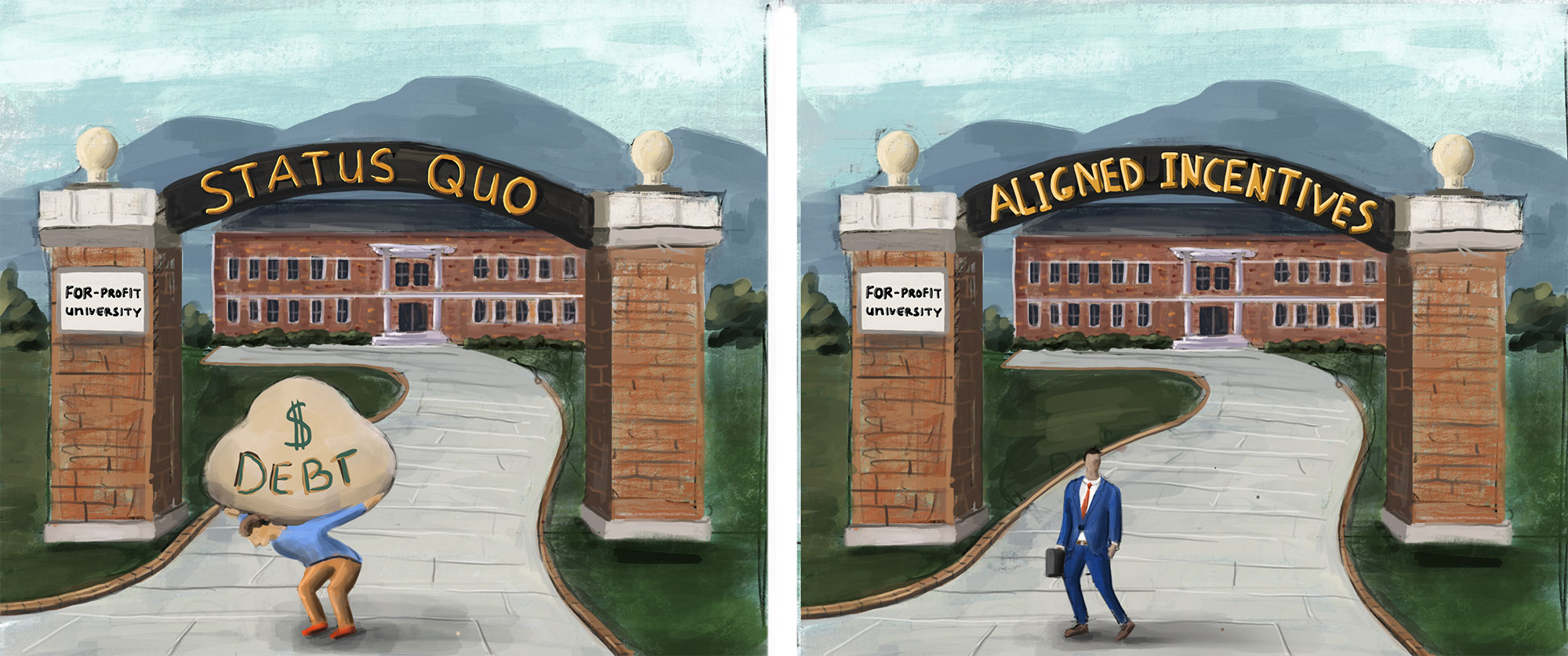
Many for-profit colleges, like many publicly funded community colleges, are failing American students. The best way to improve higher education is to harness entrepreneurial innovation, aligning incentives so that for-profit colleges earn financial rewards only if they help students succeed in the American economy.
Our Western framework of property rights and other freedoms rewards entrepreneurs who succeed in bringing people together to execute clever ideas about how to serve others. The way to harness entrepreneur-driven innovation at the college level — a major step towards broader education reform — is to ensure that for-profit colleges have their profit incentives aligned with students’ success. If we carefully tethered for-profit college profits to the future salaries of students, higher-education entrepreneurs with students’ interest in mind would be allowed in to compete and revolutionize education, resulting in more high-paying jobs and greater career success for millions of students.[1]
American for-profit colleges (FPCs) have an abysmal record of preparing students for successful careers. Lured into enrolling by flashy billboard advertisements and cheap loans, FPC graduates are less likely to be employed and face lower earnings than their public-school counterparts.[2] As a consequence, 52% of FPC students buckle under the weight of their student loans (vs. 13% of public school students).[3] Meanwhile, 2.5 million STEM jobs will go unfilled in 2018, and millions of students are being steered into frivolous Bachelor’s and Associates of Arts degrees instead of trade schools and vocational training programs.[4][5][6]
Federal government student loans account for at least 70%, and often up to 90% of for-profit college revenues, but our government does little to ensure that FPC executives are motivated to do what’s best for the country. [7][8] In fact, the federal government often richly rewards FPCs that underperform their peers. Take, for example, the following pair of for-profit colleges:

Although Grand Canyon University was extraordinarily more profitable than Strayer University on a per student basis, its students earned only marginally higher salaries and were less upwardly mobile than lower-income students at Strayer University. This is a completely unacceptable outcome. Instead, Secretary DeVos should combine the best features of free markets and Obama-era gainful employment regulations in the form of a scalar rewards policy in which FPC profits increase in lock-step with the real salaries of their graduates.
One strategy for aligning for-profit colleges with the career success of their students is to introduce what we call a “synthetic income share agreement”. Whereas in a traditional “income share agreement”, the government would loan money to students in return for a stake in their future income, we propose that the federal government grant money to FPCs proportionate to the salaries of their past graduates.
A grant to an average FPC could be around 105% of the last year’s outlay. Assuming a normal distribution, a school whose graduates perform a standard deviation above the mean would receive 139% of last year’s funding; a school whose graduates perform two standard deviations below the mean would receive 57.5% of last year’s funding, etcetera.
A scalar rewards model would unleash all the positive forces of capitalism, forcing board members, administrators, and educators to focus on producing high-earning students. Top financial analysts and investors would intensely scrutinize emerging signs and data to determine what coursework is working and help successful schools grow much more rapidly than they could as government sponsored or non-profit entities. Finance can be enormously destructive when at odds with the interests of our communities, but aligning brilliant financial minds towards the career success of our young people will advance education in ways that we can scarcely imagine.
In this new, competitive system, schools like Grand Canyon and Strayer would have to innovate rapidly or die. They would try out various approaches such as:
· Addressing quantified skills gaps by focusing on professions such as vocational nursing, K-12 education, and construction — and teaching work-ready skills.
· Partnering with large corporations in need of new recruits; using industry certification programs to communicate with potential employers instead of traditional credentials; developing databases of regional businesses and their hiring needs. [9] Most mid-to-large companies would love dedicated recruiting programs, but do not currently have them.
· Offering classes in the evenings when continuing-education students such as single moms and full time workers can actually attend them. Today, 30% of undergraduates in America are over the age of 25, and 25% of full-time college students are also working full-time.[10]
· Tinkering with the ratio of online educational material to focused physical classroom time or 1-on-1 mentorship sessions; conducting prior learning assessments; concentrating classes into 8-week vs. 16-week terms and seeing what gets results and is profitable for all involved.
Schools would independently test which strategies work for them, with marketplace competition determining what scales and succeeds. As in any other capitalist system, solutions for particular student demographics and geographical regions will vary, and the blend of educational techniques employed will fluctuate in real-time in response to changing labor market conditions. Private sector educational institutions, which are more nimble and adaptable than public schools, are ideally situated to swiftly respond to the automation of inefficient industries and the introduction of new forms of labor.
One objection to our proposal is that colleges and universities will naturally be incentivized to cherry-pick students from wealthy families, who are more likely to earn higher salaries after college. Policymakers could adjust for these types of effects by adjusting funding to schools with a regression that accounts for parental income in cases where students’ parents are socio-economically challenged. Thus, in the example above, adjusting median graduate income for the median family income of students would likely make Strayer University more profitable per student than Grand Canyon University. Policymakers will have to refine their funding calculus to account for this objection and others as they strive to implement a fair, bipartisan education policy.
Education in America will continue to be suboptimal until it reinforces the pillars of liberty, open innovation, and good profit upon which Western Civilization rests. The only major education reforms worth supporting are those that enable entrepreneurial educators to compete, experiment, and innovate to better prepare students to succeed in the labor market — scaling the ideas that work and eliminating the schools that do not. To address the shortcomings of our education system we must hew to the liberal, bottom-up policy frameworks that make our country great, and reforming for-profit colleges is one obvious place to start.
Joe Lonsdale
Partner, 8VC
8VC is a San Francisco based venture capital firm investing in industry-transforming companies. For more information, or to sign up for our newsletter visit www.8vc.com
Grand Canyon University recently converted to a non-profit, but was a for-profit college at the time of 10k filing.
[1] Approximately 2.5 million STEM jobs will go unfilled in 2018. See: Smith, Lamar. “To fill STEM jobs, federal programs need to focus on results.” Committee on Science, Space, & Technology. December 20, 2017.
[2] Cellini, Stephanie and Nicholas Turner. “Gainfully Employed? Assessing the employment and earnings of for-profit college students using administrative data.” NBER, 2018.
[3] Scott-Clayton, Judith. “What Accounts for Gaps in Student Loan Default, and What Happens After.” Brookings, June 21, 2018.
[4] Smith, Lamar. “To fill STEM jobs, federal programs need to focus on results.” Committee on Science, Space, & Technology. December 20, 2017.
[5] Schneider, Mark and Matthew Sigelman. “Saving the Associate of Arts Degree.” AEI,
[6] McCarthy, Pat. “Leading Practices for the State’s Secondary Career and Technical Education Programs.” Office of the Washington State Auditor. December 19, 2017.
[7] Kelchen, Robert. “How much do for-profit colleges rely on federal funds?” Brookings, 2017.
[8] Cellini, Stephanie Riegg. “For-profit higher education: an assessment of costs and benefits.” National Tax Journal, March 2012.
[9] Monroe Community College in Rochester, NY has begun using this database model. See: Alvarez, Joshua. “The Twelve Most Innovative Colleges for Adult Learners.” Washington Monthly, October 2017.
[10] Kelly, ibid.

